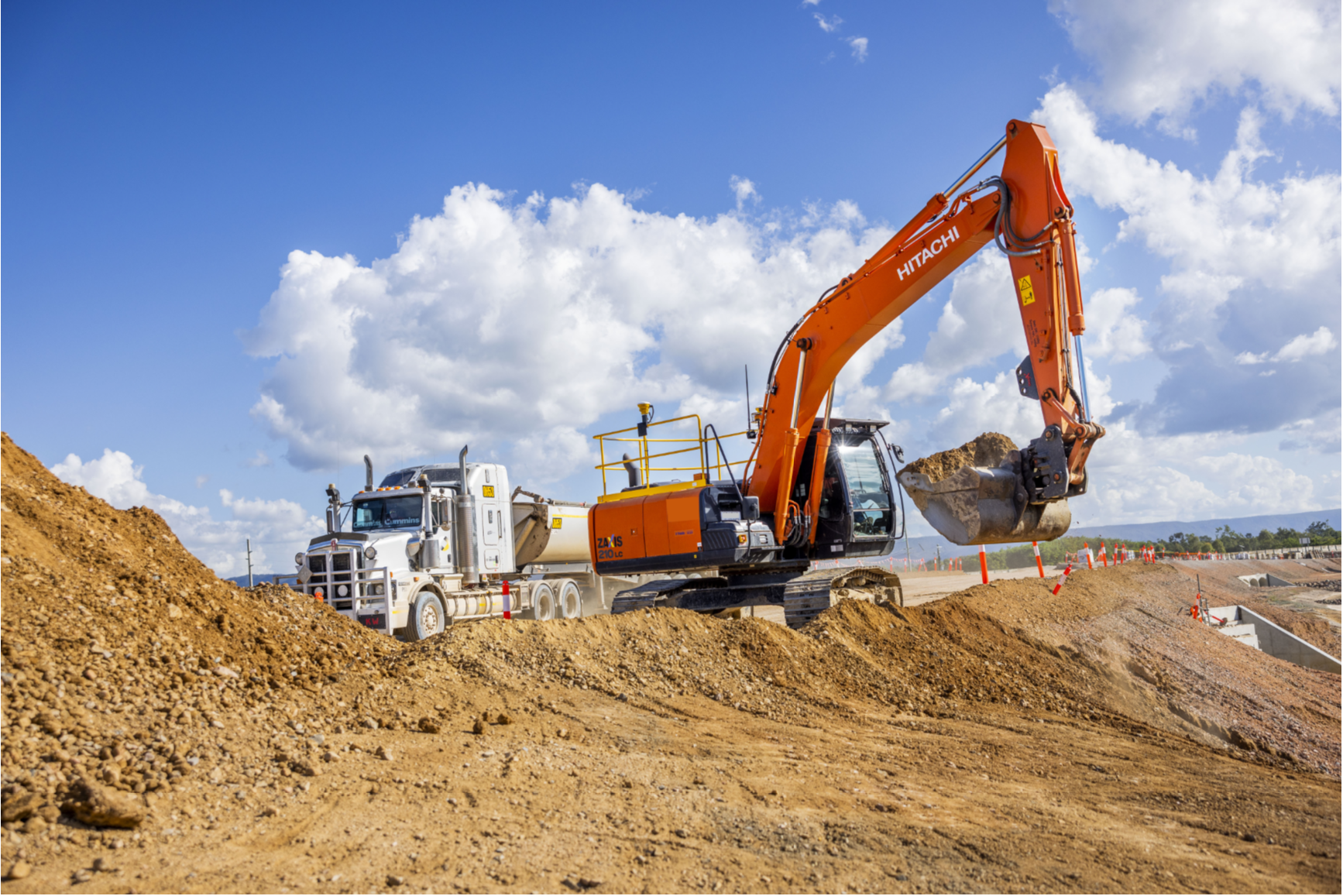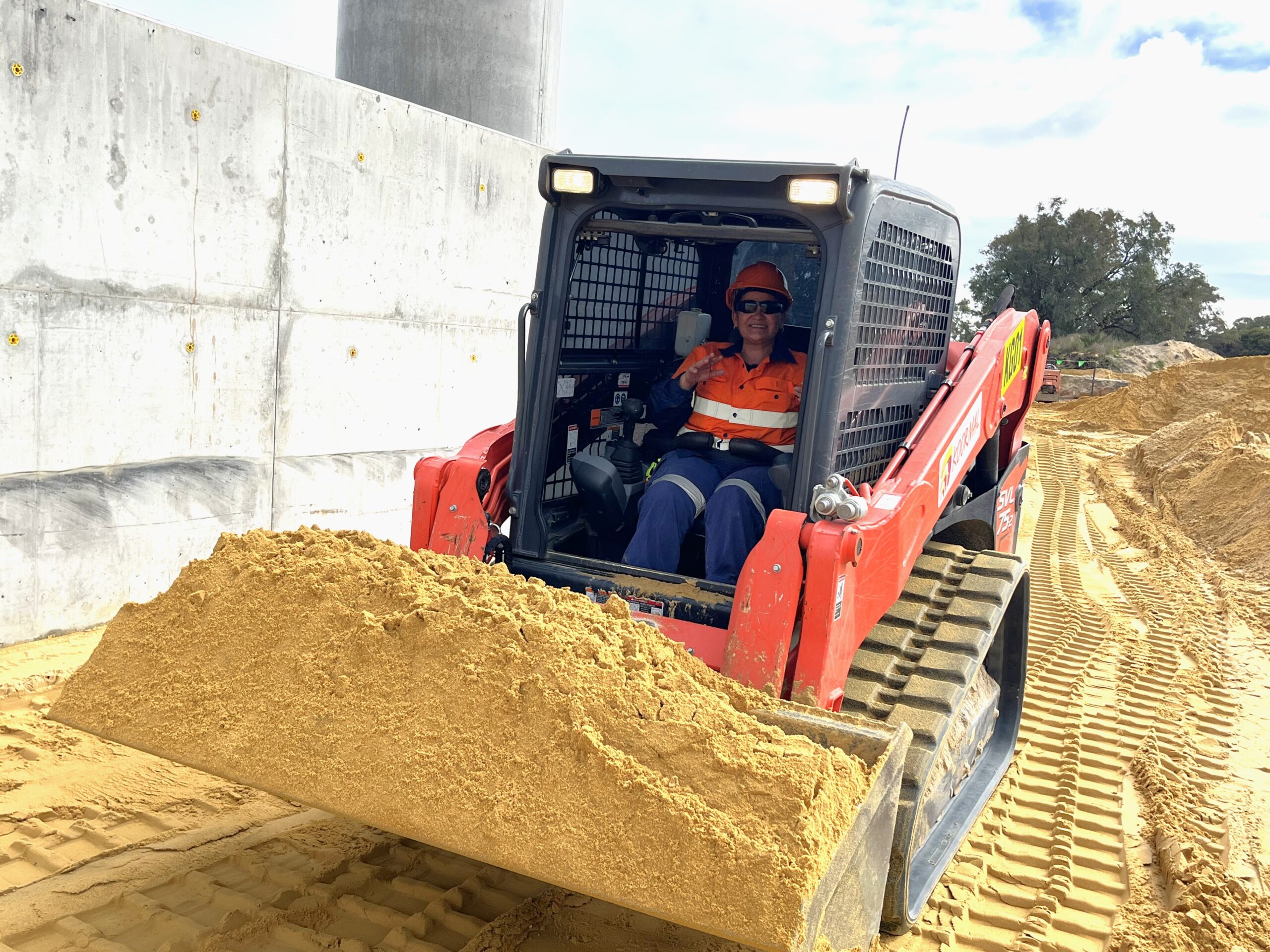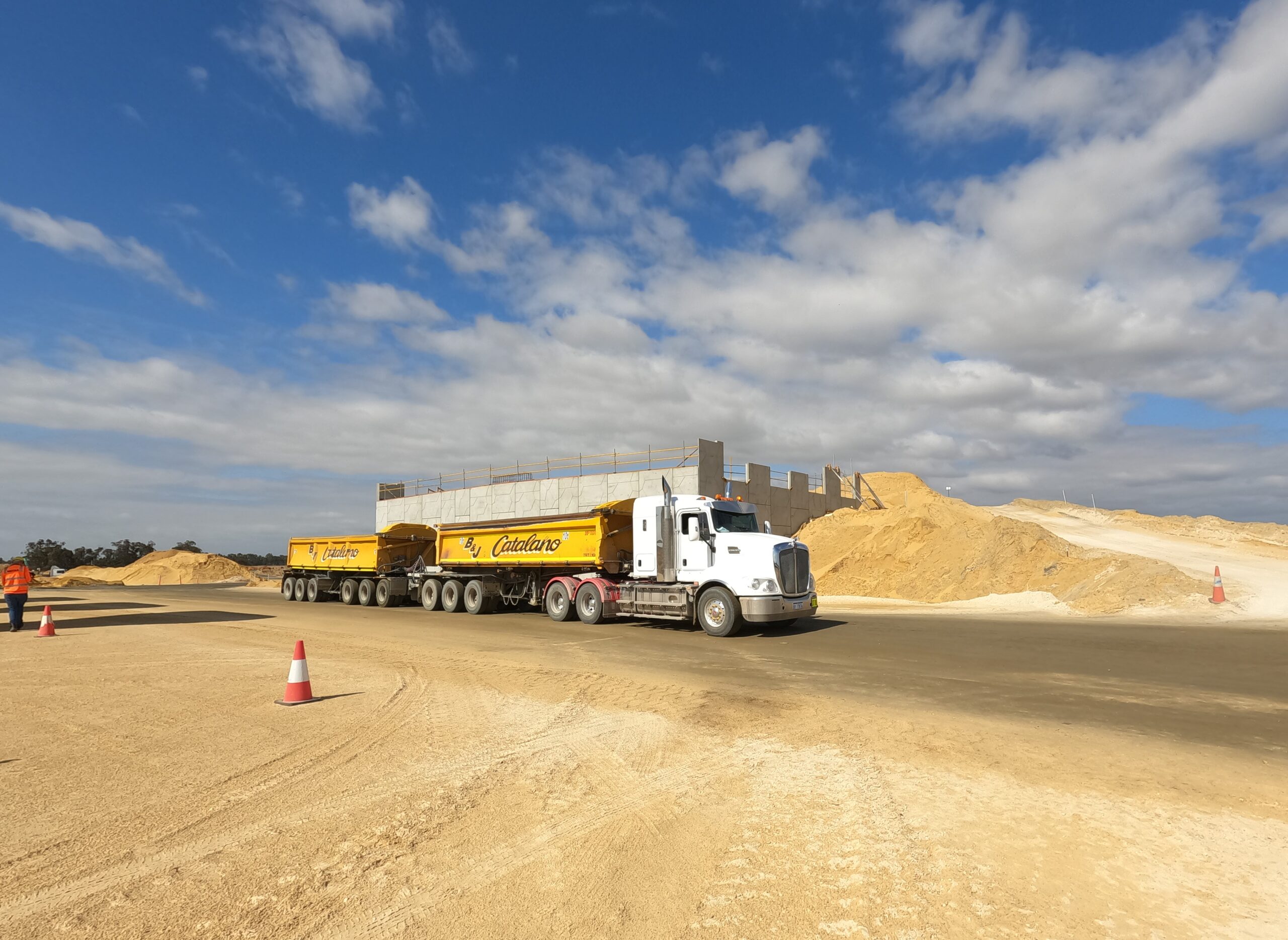Describe what you have done and how you have done it
The Townsville Ring Road (Stage 5) (TRR5) project team delivered positive economic outcomes through collaborative development of alternative technical specifications when designing and constructing embankments as part of a six-kilometre Bruce Highway duplication project in North Queensland.
During the project’s tender phase, the TRR5 project team identified several key risks relating to the production and supply of embankment fill material from on site or local quarry suppliers. These risks, associated with production capacity, pricing, processing requirements, and the general unsuitability of local rock strata, would make it difficult for the project to meet Department of Transport and Main Roads (TMR) technical specifications. Recognising the significance of these challenges, the team strived to instigate an innovative market transformation by developing an alternative embankment fill specification from TMR’s standard MRTS04 General Earthworks specification. The team aimed to not only address immediate supply risks, but to also establish validated and acceptable practices that could inform future construction projects and support local businesses.
Sodic soils, which are prevalent in the Townsville region, are generally considered “poor” and “unsuitable” under the MRTS04 requirements due to their structural instability, high erodibility, high level of dispersiveness and low soil fertility. The key feature of the alternative specification developed was its allowance for the use of these unsuitable soils by changing the embankment design to accommodate a sodic core, with a protection layer to eliminate contact and damage during flood events.
By enabling the use of sodic soils, the alternate specification fostered regional circular economy benefits and significantly reduced the amount of cut material that would otherwise be disposed of in landfills as non-compliant and unusable. This reduction in disposal lowered the burden on local quarries to provide sufficient imported fill volumes to compensate for the discarded material. In turn, this reduced the virgin material extraction, blending and processing compliance requirements at local quarries, ultimately leading to reduced emissions.
The amended specification was triggered through recognition of the potential resource that the excavated material could provide for the project. Validation and testing of fill material were undertaken with TMR’s Engineering and Technology experts, regional staff, local soil scientists, local geotechnical engineers, and project team representatives. By using the combined skills of this collective, the structural integrity of the proposed design was able to be confirmed as satisfactory to meet an amended TMR technical specification. This analysis was then complemented by defining related conformance criteria.
Vendor analysis was conducted to assess local quarries and demonstrate their capability to provide materials meeting the alternative specification requirements. A collaborative working group conducted regular meetings to discuss and analyse the intricate aspects of applying an alternate specification. These discussions focused on determining specific conformance characteristic limits, which led to further refinement, acceptance, and improved usability of the final amended specification.
Through this collaborative work, the project was able to demonstrate a realised cost reduction of more than $5.7 million, with total potential savings exceeding $10 million.
What were the outcomes and how were those outcomes shared?
The positive economic outcomes of the TRR5 alternate embankment initiative included significant transport, processing, and disposal cost savings as well as the utilisation of more cost-effective and environmentally sound material. The final approval and implementation of the MRTS04.1 annexure allows these benefits to be secured by future projects, providing a lasting legacy for the region.
The use of alternate embankment material presented several advantages for the project team including reduced cost and reduced program risk. Reusing site-won material allowed for the use of large quantities of readily-available material and reduced waste by negating the need for disposal of cut material offsite.
The realised commercial outcomes of the initiative centred on the cost savings associated with reduced transport both in diesel and haulage, reduction in disposal costs and reduction in material costs.
Through the project’s calculations, it was determined by utilising site-won material, an energy saving of around 680 kL of diesel was achieved, equating to a saving of $1.3 million. This figure covered transport that would have been required for the removal and disposal of cut material (around 150,000m3), as well as the import of new fill from the nearby quarry.
All material extracted onsite was reused in embankment construction for the project, resulting in a cost saving of over $4 million. This was calculated by determining the market cost of the typical A1 and A2 class material that would have been required. A further $300,000 was saved by supplementing an A1 class base material with a locally available product for all embankments.
A key learning that could produce economic benefits for future projects, is the cost associated with the disposal of unsuitable material at a landfill site. The project was able to estimate that based on market prices, quantities, and transport costs, an additional $4.5 million would have been required to dispose of sodic soils at local landfill sites.
In addition to positive project outcomes, the implementation of the amended technical specification provided significant benefits to the local market:
• Efficient resource management: By changing embankment design and fill requirements, the specification will enable more efficient resource management in the region’s supply chain. This will be achieved by reducing wasted cut material from projects, improving the overall cut-to-fill balance within a project, and consequently reducing the burden on the production capacity of local quarries to compensate for the disposed cut material.
• Local procurement and economic contribution: The changed specification allowed for the use of local quarries, promoting higher local procurement and contributing to the regional economy. This approach prevented negative impacts on quarry productivity associated with additional manufacturing processes and reduced overall project costs that would have arisen from sourcing processed materials locally or importing them from distant suppliers.
• Material and waste benefits: The specification facilitated the reuse of materials, avoiding the need for extra processing and blending. This not only resulted in material and waste benefits but also had positive energy implications by reducing the import and export of materials and streamlining logistics.
• Knowledge growth and industry engagement: The involvement and engagement of local industry stakeholders in developing the specification contributed to knowledge growth in the region. This collaborative approach fostered the sharing of expertise and experiences, further enhancing the industry’s understanding of alternative designs and acceptable materials.
The TRR5 project’s success in addressing material challenges and development of the amended technical specification laid the foundation for market transformation. Recognising the potential for a more generalised specification highlighted the need for broader engagement with representatives from the TMR Northern District and E&T to address locally identified constraints. This involvement ensured that future projects would not have to undergo the extensive testing and approval processes undertaken by the TRR5 project.
The project’s achievements demonstrate the successful development and implementation of the TRR5 specification, leading to market benefits, knowledge growth, and the potential for broader industry adoption. These benefits will extend to future construction projects in the region by enabling the use of locally available resources and suppliers.
Describe who benefited from your initiative, innovation, or approach?
The innovative specification development undertaken by the project has benefited multiple stakeholders involved in the process and will also benefit future projects. These include:
• Local Townsville Quarries: The burden on local quarries to supply ample fill volumes as a result of discarded material was alleviated through this specification. The developed specification reduced the blending and processing requirements at quarries to meet compliance, leading to improved quarry productivity and reduced embodied emissions.
• Engineering and Technology Division of TMR (E&T): The E&T division, specifically the Design Verification Team (DVT), has greatly benefited from the project’s alternative material specification. By collaborating with the project team and engaging in the development and implementation of the TRR5 specification, the DVT has gained valuable insights and knowledge regarding the use of dispersive and sodic soils. This experience will inform future updates to the standard MRTS04 specification and potentially lead to the development of a new Technical Note. The DVT’s involvement ensures that the benefits and lessons learned from the project can be shared and applied on other projects across TMR.
• Site-Based Verification Team and Administrator: The site-based verification team and administrator have directly benefited from the alternative material specification. Their role involves overseeing the implementation of the TRR5 specification on-site, conducting conformance tests, and monitoring the processing and performance of the material. Through their involvement, they gain practical experience in working with the alternative material and contribute to the development of best practices for its use. This knowledge enhances their expertise and expands their skill set in managing similar projects in the future.
• Local TMR Representatives: Representatives from TMR’s Soil Testing Division in Townsville, have benefited from the project’s initiative. Their involvement in the collaborative working group and engagement with local industry stakeholders has provided first-hand exposure to the challenges and solutions related to the use of alternative materials. This experience has enhanced their understanding of soil testing methodologies, improved their ability to assess the suitability of different materials, and will contribute to the development of future specifications and guidelines.
What Legacy and UN SDG contribution was achieved?
The legacy of the above discussed initiative aligns with the United Nations Sustainable Development Goal 9: Industry, Innovation and Infrastructure. This goal focuses on building resilient infrastructure, promoting inclusive and sustainable industrialisation, and fostering innovation. The project’s alternative material specification and collaborative approach contribute to the following aspects of Goal 9.
• Infrastructure Development: The project’s alternative material specification enables more efficient resource management within the region’s supply chain. By reducing wasted cut material from projects and improving the cut-to-fill balance, the initiative promotes the development of resilient infrastructure. It also reduces the burden on local quarries by utilising locally available materials, which supports the growth of sustainable infrastructure in the region.
• Sustainable Industrialisation: The project’s approach promotes sustainable industrialisation by facilitating higher local procurement and contribution to the local economy. The relaxation of material requirements allows the use of local quarries without additional processing and blending requirements, minimising negative impacts on quarry productivity. This supports the development of a sustainable industrial sector by reducing costs, improving productivity, and minimising the environmental footprint associated with material importation and manufacturing processes.
• Innovation: The project’s alternative material specification represents an innovative approach to embankment fill requirements. By enabling the use of dispersive and sodic soils, which were previously considered unsuitable, the project breaks new ground in materials management and utilisation. This innovation not only addresses the specific challenges faced by the project but also provides a precedent for future projects to adopt similar approaches. The development of a more general specification based on this project’s findings will foster further innovation and knowledge growth in the region.
• Collaboration and Knowledge Sharing: The project’s legacy includes collaboration with various stakeholders, such as TMR representatives, soil scientists, geotechnical engineers, and the project team. This collaborative approach fosters knowledge sharing, capacity building, and industry engagement. By involving local industry experts and representatives from TMR’s different divisions, the project ensures a comprehensive understanding of the alternative material’s viability and applicability. The shared knowledge and experience gained from this collaboration can be utilised in future projects, accelerating sustainable development within the industry.
• Waste Reduction and Environmental Benefits: The alternative material specification significantly reduces the amount of cut material disposed of as non-compliant waste. This waste reduction contributes to a more circular economy by minimising landfill usage and conserving natural resources. Additionally, the specification reduces the need for blending and processing of materials, thereby reducing embodied emissions at quarries and minimising the project’s overall environmental impact.
Additionally, by virtue of the active participation of TMR Engineering and Technology Division (E&T) in the execution of the alternative material specification, E&T is equipped to deliver a lasting legacy of MRTS04 modifications for forthcoming projects in the region.
The legacy of the discussed topics aligns strongly with the principles and objectives of Sustainable Development Goal 9. The project’s alternative material specification promotes sustainable infrastructure development, supports sustainable industrialisation, fosters innovation, encourages collaboration and knowledge sharing, and contributes to waste reduction and environmental benefits. By addressing these aspects, the project leaves a lasting impact on the industry, paving the way for more efficient, sustainable, and innovative practices in the future.



